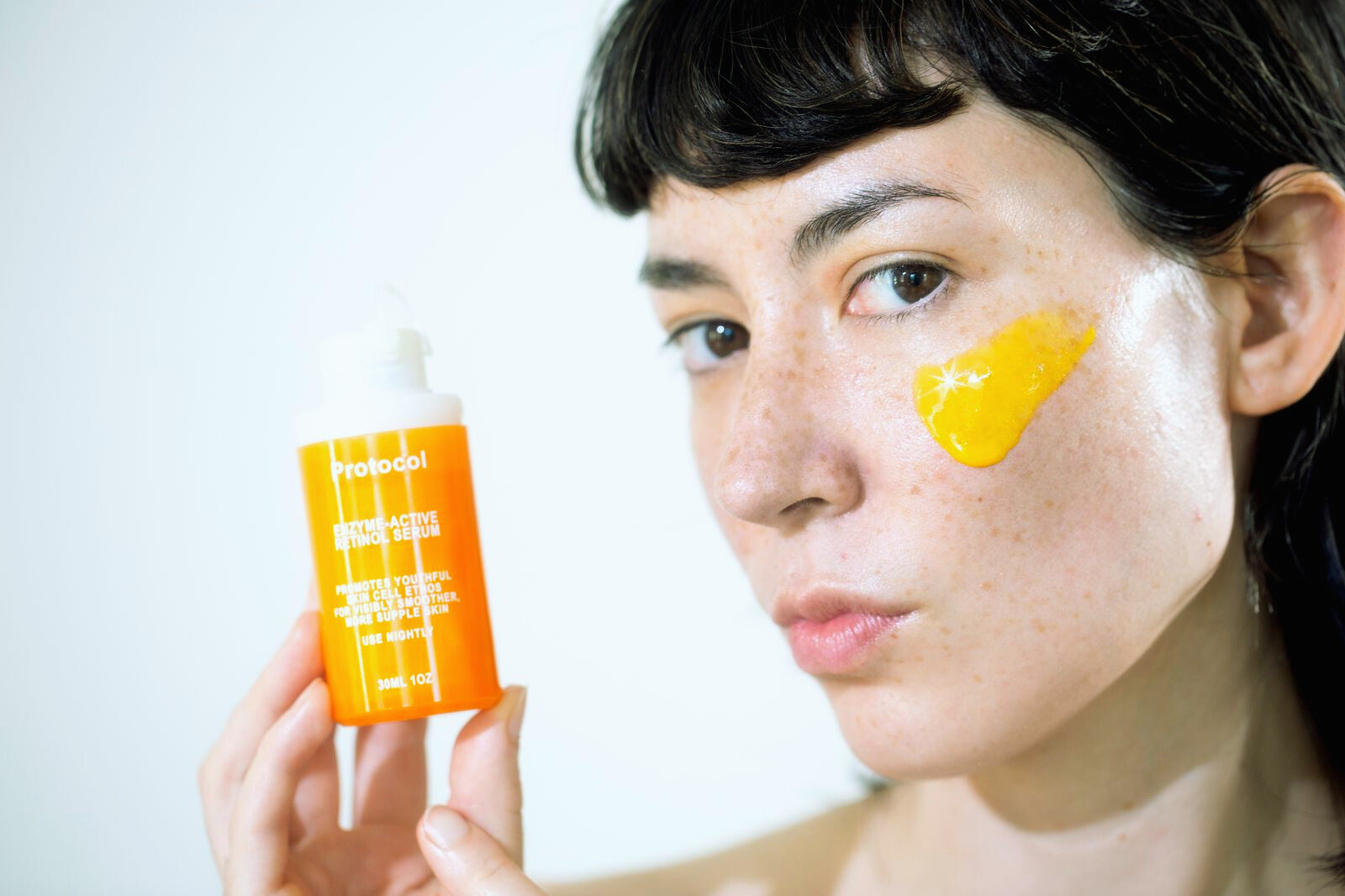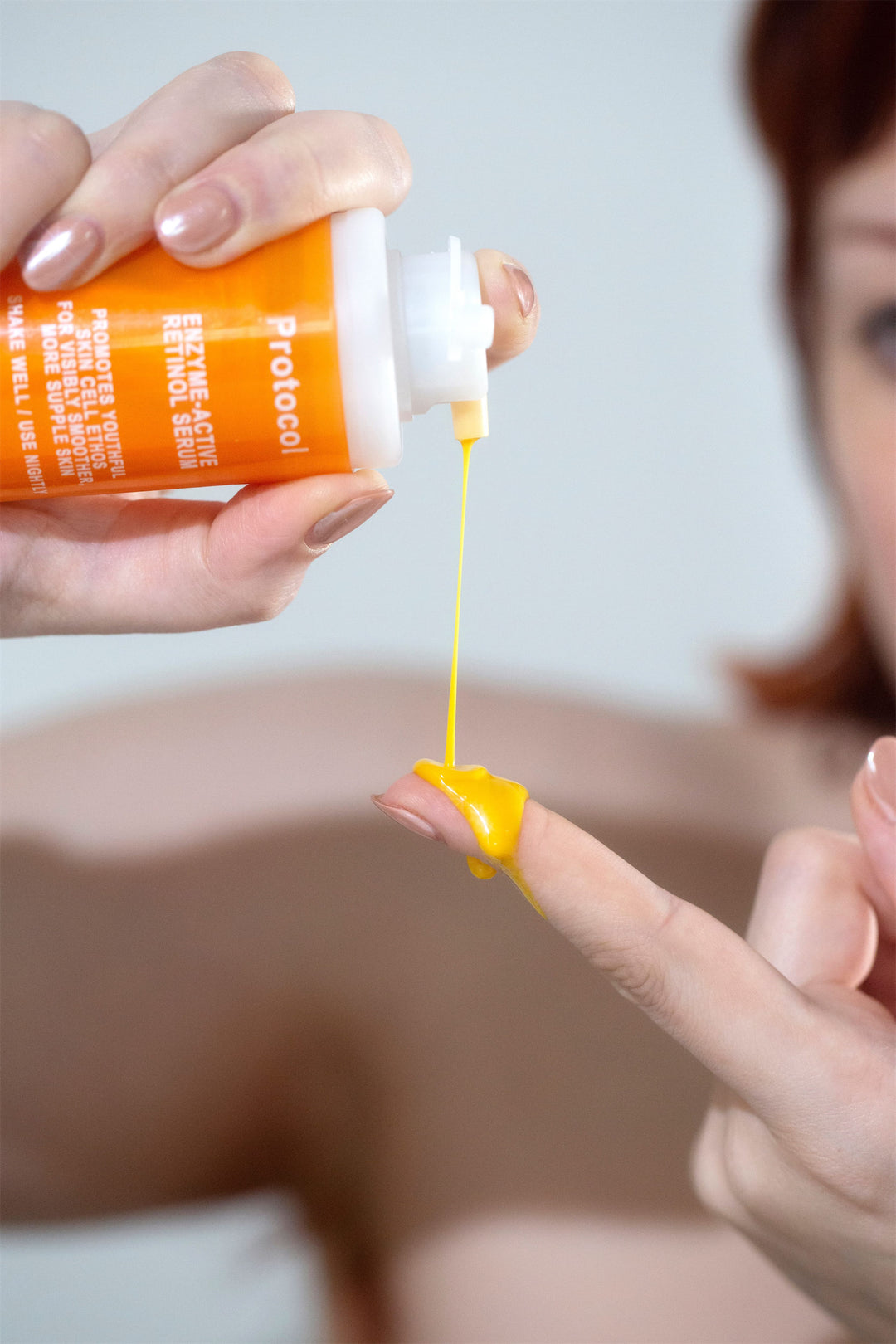Retinol vs Retinaldehyde: Which Is the Best Retinoid?

Trying to choose between retinol vs retinaldehyde? If so, this guide is for you.
Skintellectuals know that retinoids are essential for youthful, healthy skin.
If you’re looking to refine or improve the appearance of your skin, especially texture, signs of aging, discoloration, or even blemishes, then using a retinoid in your routine is a must.
You’ll find all sorts of retinol options in skincare and prescription products, but retinol and retinaldehyde are the two key players in the cosmetic space.
You certainly know about retinol already, but retinaldehyde (aka retinal with an a) needs to be on your radar. In this retinol vs retinaldehyde showdown, we’ll dig into the two superstars, compare their benefits, strength, gentleness, and more to explain why our Lab Team opted for retinal as the key ingredient in our award-winning Enzyme Active Retinol Serum.
What is retinol?
Retinol is the most commonly used form of vitamin A in skincare. It’s used in serums and night creams to fight signs of aging, improve skin texture, help fade breakouts and discoloration, and drive the skin toward smooth, shiny health.
Retinol doesn’t impact the skin directly. It works through a two-step conversion process. Once applied to the skin, enzymes in the skin oxidize it into retinaldehyde. Next, they convert retinaldehyde into retinoic acid (RA), which is the form of vitamin A the skin actually uses. As a result, it’s fairly mild (although it can still be irritating to some).
What is retinaldehyde?
Retinaldehyde (retinal) is basically the next step in the conversion. In other words, it’s a more bioavailable form of vitamin A. Once applied to the skin, enzymes transform retinaldehyde into retinoic acid. Because the conversion second step is much more efficient, the result is an ingredient with more powerful skin-transforming properties.
Retinol vs retinaldehyde: Benefits, strength, gentleness, and more
|
Feature |
Retinol |
Retinal |
|
Conversion to Retinoic Acid |
2 Steps 🔄🔄 |
1 Step 🔄 |
|
Effectiveness |
Weak 🤏 |
Up to 20x stronger (but gentle) 💪 |
|
Time to Results |
Slower ⏳ |
Faster 🚀 |
|
Skin Benefits |
Anti-Aging, Acne, Brightening ✨ |
Same benefits, more power ⚡ |
|
Irritation Potential |
Varies |
Gentle yet effective 😊 |
|
Stability |
More stable 📦 |
Less stable ⚠️ |
Benefits
When comparing the benefits of retinol vs retinaldehyde, the truth is that they both offer the same skin renewal effect. They promote faster, healthier skin renewal and differentiation, which is why they can address a lot of different skin concerns, including:
Anti-aging: Both retinol and retinal have an anti-aging effect, helping to prevent and reduce signs of aging like fine lines, wrinkles, and loss of skin firmness. According to research, retinal’s anti-aging effects are on par with retinoic acid, making it the stronger option.
Brighter, more even skin tone: Retinol and retinal can both help prevent and improve the appearance of discoloration, to create clearer, more even-toned skin (especially in combination with other vitamins for dark spots).
Reduce or fade blemishes: Retinoic acid helps unclog pores from dead skin cells and sebum, which is why it helps reduce breakouts. By turning into RA more effectively, early studies show that retinaldehyde may also help improve the appearance of acne-prone skin, especially when paired with glycolic acid.
Strength and efficacy
While the benefits are similar, the main difference between retinal vs retinol is the effectiveness level and the speed with which you can expect to see results. As you can already guess, the strength of different retinoids comes down to how directly they can impact the skin.
Retinal’s one-step conversion makes it at least 10 times more bioavailable than retinol, leading to faster and more effective skin transformation. This is also why it’s commonly used at percentages between 0.05%-0.1%, compared to retinol which is normally used at 0.3%-2%.
Gentleness: Retinal or retinol for sensitive skin
You’d think the stronger retinoid would also be harsher on the skin, but in the case of retinol vs retinaldehyde, that’s not the case at all.
Despite its greater impact on the skin, retinal is just as gentle and sensitive-skin friendly as retinol, which is why it’s the best cosmetic alternative to prescription-only retinoids. In studies testing retinal, retinol, and retinoic acid, both retinol and retinal were found to be significantly less likely to cause redness, flaking, or itchiness compared to retinoic acid.
The reason why retinal is so gentle despite its high level of efficacy lies in its conversion process. As researchers explain, retinaldehyde converts into retinoic acid only in the skin cells that are at the appropriate stage of differentiation (i.e., the stage when they switch from being simple skin cells lower in skin into specific cells with a job).
This is very important because it means it works exactly when and where it’s needed, without overstimulating the skin.
The remaining retinaldehyde converts into retinyl esters, which serve as a storage form of vitamin A in the skin, helping to provide continuous but very mild skin renewal through a slightly less efficient conversion process.
Moreover, modern formulations like in the Enzyme-Active Retinol Serum feature a microencapsulated retinal, which further limits the risk of irritation.
Stability
With both retinol and retinaldehyde, stability presents the greatest formulation challenge. Both degrade rapidly when exposed to oxygen, sunlight, and extreme temperatures. Sadly, many manufacturers don’t take the necessary steps to protect them.
If you haven’t seen signs that your retinol is working after months of use, the formula may have degraded due to exposure to air, heat, or UV light during storage or transport — or the bottle itself may not be effective at protecting the ingredients.
If that’s been your experience, it’s time to switch to a stronger, more bioavailable retinaldehyde product, and ideally one that remains pure and potent through responsible and meticulous formulation and bottling processes, like the Enzyme-Active Retinol Serum.
FAQ
Is 1% retinol the same as 1% retinal?
No, 1% retinol is not the same as 1% retinal. Because of its more direct skin impact, retinal is much stronger than retinol. That’s why it’s usually formulated at 0.1%. Even when used at 0.1%, our clients often find that retinaldehyde offers faster and more significant skin improvements compared to 1% retinol.
Does retinol turn into retinal?
Yes! Once applied to the skin, enzymes oxidize retinol and transform it into retinal. This is retinol’s first step of conversion. After becoming retinal, it is next oxidized into retinoic acid, which is the form of vitamin A that transforms and rejuvenates the skin. Unfortunately, retinol’s 2-step conversion is very inefficient compared to retinal’s conversion, which is why we consider retinal the best OTC retinoid in the cosmetic world.
Is retinaldehyde good for beginners?
Definitely! Despite its potency, retinal is beginner-friendly and well-tolerated by most skin types. It’s mild, so it’s unlikely to cause irritation. If you are nervous or have sensitive skin, introduce it gradually just a few days a week, and slowly increase frequency while observing its effects on your skin.
Is there a difference in how I should use retinol vs retinal?
No, the process of using retinol is the same as the process of using retinal. No matter which one you choose, they’re best used at night when your skin is primed for recovery. We recommend applying your retinoid directly to damp, clean skin, and following up with your hydrating or moisturizing products. Make sure to use sunscreen in the daytime.
Discover the Top Retinaldehyde Serum
The winner of the retinol vs retinaldehyde debate is clear: Retinal is the best retinoid for those seeking powerful results without the irritation.
Its faster conversion, higher bioavailability, and ability to deliver script-level effects while still being gentle make it an obvious choice for anyone looking to improve how their skin looks and feels. That’s certainly the reason why our Lab Team favors retinal over retinol.
Tried retinol with little success? Upgrade to retinal for faster, more visible results. A well-formulated retinal product will give your skin the most potent yet balanced dose of vitamin A, for the smooth, youthful, and clear skin you crave.
Unfortunately, not all retinal products are created equal. Many degrade quickly in poor packaging, making them ineffective before they even reach your skin. That’s why our Enzyme Active Retinol Serum is bottled using airless, medical-grade technology: So every drop stays potent, stable, and effective.
References
1. Zasada, Malwina, and Elżbieta Budzisz. “Retinoids: active molecules influencing skin structure formation in cosmetic and dermatological treatments.” Postepy dermatologii i alergologii vol. 36,4 (2019): 392-397. doi:10.5114/ada.2019.87443
2. Creidi, P et al. “Profilometric evaluation of photodamage after topical retinaldehyde and retinoic acid treatment.” Journal of the American Academy of Dermatology vol. 39,6 (1998): 960-5. doi:10.1016/s0190-9622(98)70270-1
3. Kim, Jihee et al. “A pilot study evaluating the efficacy and safety of retinaldehyde-loaded niosomes against mild-to-moderate acne.” Journal of cosmetic dermatology vol. 20,11 (2021): 3586-3592. doi:10.1111/jocd.14478
4. Dréno, B et al. “Topical retinaldehyde with glycolic acid: study of tolerance and acceptability in association with anti-acne treatments in 1,709 patients.” Dermatology (Basel, Switzerland) vol. 210 Suppl 1 (2005): 22-9. doi:10.1159/000081500
5. Konisky, Hailey et al. “The Clinical Efficacy and Tolerability of a Novel Retinaldehyde Serum with Firming Peptides to Improve Skin Texture and Signs of Photoaging.” Journal of drugs in dermatology : JDD vol. 23,11 (2024): 992-997. doi:10.36849/JDD.8058
6. Fluhr, J W et al. “Tolerance profile of retinol, retinaldehyde and retinoic acid under maximized and long-term clinical conditions.” Dermatology (Basel, Switzerland) vol. 199 Suppl 1 (1999): 57-60. doi:10.1159/000051381
7. Kwon, Hyuck Sun et al. “Efficacy and safety of retinaldehyde 0.1% and 0.05% creams used to treat photoaged skin: A randomized double-blind controlled trial.” Journal of cosmetic dermatology vol. 17,3 (2018): 471-476. doi:10.1111/jocd.12551




